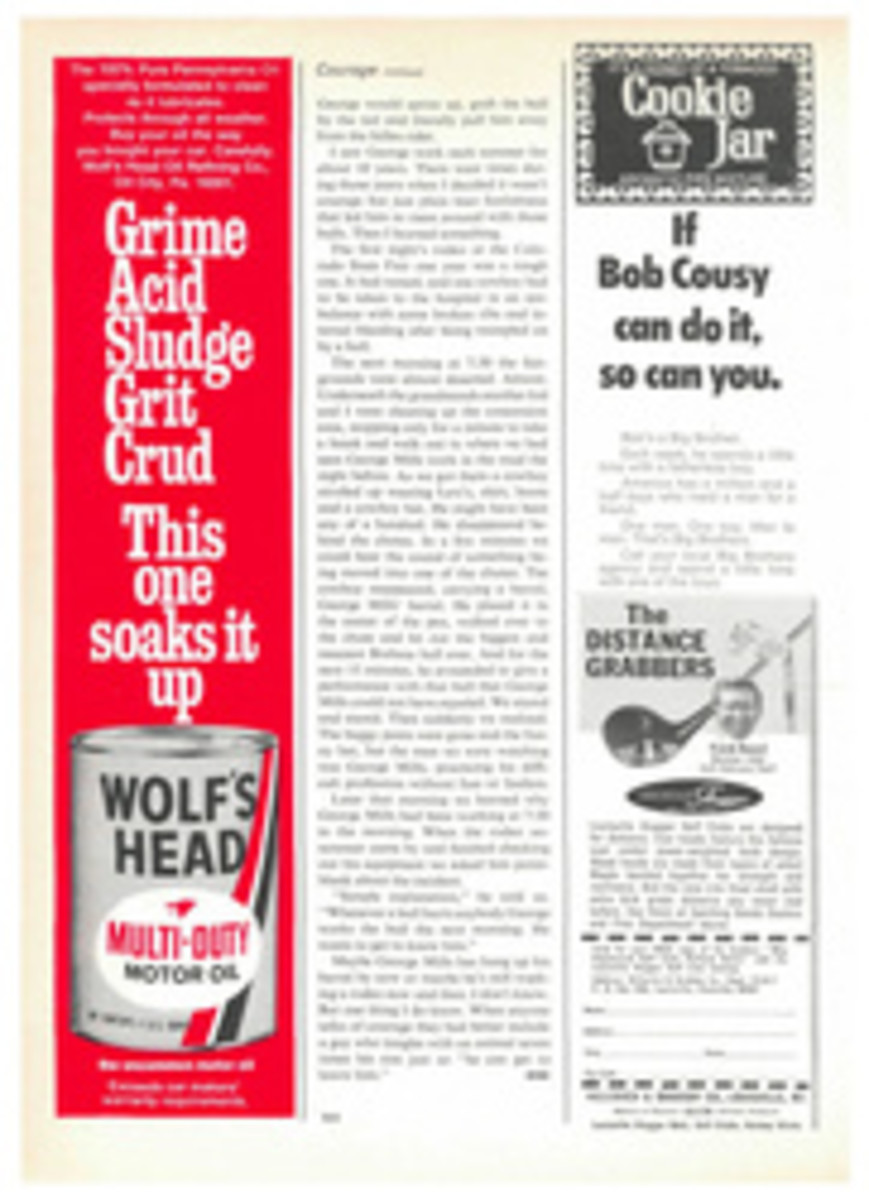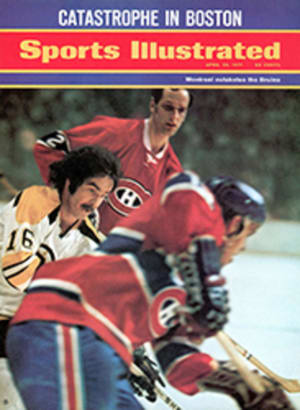
The Funniest Courage of All
I guess most kids grown to manhood in the U.S. have something common to all their memories: mumblety-peg, steelies, skinnin'-the-cat and the wonderfully dust-filled redolence of a crowded arena on a hot summer's night, with prancing horses on parade and clowns and Cracker Jack and more excitement than a boy could stand. For some ex-kids that vision conjures up a circus, but for those of us who grew up where I did, it means only one thing: rodeo. Not ro-day-ohs, mind you, like they have in the East in buildings like New York's Madison Square Garden, but rodeos, with the accent on the ro.
They still have rodeos today in places like Penrose Stadium, right next to the Broadmoor Hotel in Colorado Springs, or up in Cheyenne during the festival called Frontier Days, or maybe in any number of small cowpens stretching all the way up the eastern range of the Rockies from Albuquerque to Billings.
In the old days there was always a certain order present no matter where a rodeo was being held along that range, an order that made each rodeo the same and yet absolutely different from any other you had ever seen. The order was like that of a good story: introduction, anticipation, building of tension and, finally, the climax.
First, there was a grand entrance—a hundred or more riders, each carrying a flag, trotting through a series of intricate loops and circles, moving effortlessly until horses and riders formed up into a line at rigid attention for the playing of The Star-Spangled Banner. There isn't a halftime show in the country that could touch a rodeo grand entrance for class.
Next came the trick riders, and after them the saddle bronc riders. One by one these wild centaurs burst forth until slowly the phrase, "Now comin' out of chute number nine..." drilled itself so deeply into a boy's mind that a quarter of a century later it sets a man's heart thumping with anticipation when he hears it in an old movie late at night on TV.
After saddle broncs the program moved swiftly. Steer wrestling, or bull-dogging, whichever you like to call it. Then to bareback bronc riding. Maybe a dog act or two. And calf roping.
When eventually the last calf was roped and tied, slowly around the edge of the main grandstand a tractor edged into view, dragging a pile of fencing. The crowd—whether in Montana, Colorado or Arizona—always cheered at the first sight of that tractor and eagerly watched as six or seven cowboys used that fencing to build a temporary pen inside the main arena. For all this meant the real show was about to begin: Brahma bull riding.
Bull riding was a show in two acts. The first took place while a cowboy tried to stay atop his bull for the required 10 seconds. The second show, the one the crowd really came to see, started as soon as the rider was off the bull. It starred the bull, and it starred a man. And, tall or short, skinny or fat, that man would do a job that was cheered in a thousand rodeos in a hundred arenas every summer.
That man was the rodeo clown. Once you saw a rodeo clown work a bull you swore for a long time that no braver man had ever lived. That's how I felt about the man I knew as George Mills—though whether or not that was his right name I don't know. To me, anyway, he was George, he was the first rodeo clown I ever saw and to my mind he was the bravest of the brave.
When I first saw Mills I didn't see him. When you are 8 years old the thought of watching someone get killed is a little frightening. So I hid my eyes. I figured there was no way that little man in the funny clothes in that ring with that bull could keep from being killed. But somehow he did. So the next night I looked at him. It was a wild sight. He wore blue jeans at least a foot and a half too big around the waist but held up by a pair of wide elastic suspenders. The shirt was plaid, loud plaid, as was the handkerchief he kept barely tucked into a hip pocket. The hat was early Buster Keaton, a flat, saucerlike affair. And, of course, there was the barrel. Imagining a rodeo clown without his barrel is like trying to envision Babe Ruth without a bat and just as foolish. George Mills had a job to do, and he needed that barrel to do the job.
The barrel began each performance directly in the center of the pen. And by the time Rider No. 1 came out on Bull No. 1, George was in the barrel up to his waist, peering closely at the twisting, snorting mountain of flesh that wasn't too happy about having someone sitting on its back with a cinch around its vitals. Eventually one of two things happened. Either the bull threw the rider or the rider rode out his time, got his buzzer and wanted off that bull. Once off he needed to get out of that pen—in a hurry. That was George's cue.
The moment a rider touched the ground, either by accident or design, George left the barrel and was after that bull. His main job was to distract the bull so that the rider could get out. This George did in spades.
One of his specialties was sailing his little hat about 15 feet through the air so that it hit the bull right above the eyes. Then he would nonchalantly walk over, pick up the hat and about this time the bull would decide he didn't care for the funny-looking man who was throwing things at him. Somehow George managed to dive into the barrel every time, just an instant before the bull rammed into it, hurtling it 10 or 20 yards.
Sometimes when a rider took a bad fall and was down on the ground and the bull was after him with a horn, George would sprint up, grab the bull by the tail and literally pull him away from the fallen rider.
I saw George work each summer for about 10 years. There were times during those years when I decided it wasn't courage but just plain loco foolishness that led him to mess around with those bulls. Then I learned something.
The first night's rodeo at the Colorado State Fair one year was a rough one. It had rained, and one cowboy had to be taken to the hospital in an ambulance with some broken ribs and internal bleeding after being trampled on by a bull.
The next morning at 7:30 the fairgrounds were almost deserted. Almost. Underneath the grandstands another kid and I were cleaning up the concession area, stopping only for a minute to take a break and walk out to where we had seen George Mills work in the mud the night before. As we got there a cowboy strolled up wearing Levi's, shirt, boots and a cowboy hat. He might have been any of a hundred. He disappeared behind the chutes. In a few minutes we could hear the sound of something being moved into one of the chutes. The cowboy reappeared, carrying a barrel, George Mills' barrel. He placed it in the center of the pen, walked over to the chute and let out the biggest and meanest Brahma bull ever. And for the next 15 minutes, he proceeded to give a performance with that bull that George Mills could not have equaled. We stared and stared. Then suddenly we realized. The baggy pants were gone and the funny hat, but the man we were watching was George Mills, practicing his difficult profession without fuss or fanfare.
Later that morning we learned why George Mills had been working at 7:30 in the morning. When the rodeo announcer came by and finished checking out his equipment we asked him point-blank about the incident.
"Simple explanation," he told us. "Whenever a bull hurts anybody George works the bull the next morning. He wants to get to know him."
Maybe George Mills has hung up his barrel by now or maybe he's still working a rodeo now and then. I don't know. But one thing I do know. When anyone talks of courage they had better include a guy who tangles with an animal seven times his size just so "he can get to know him."

